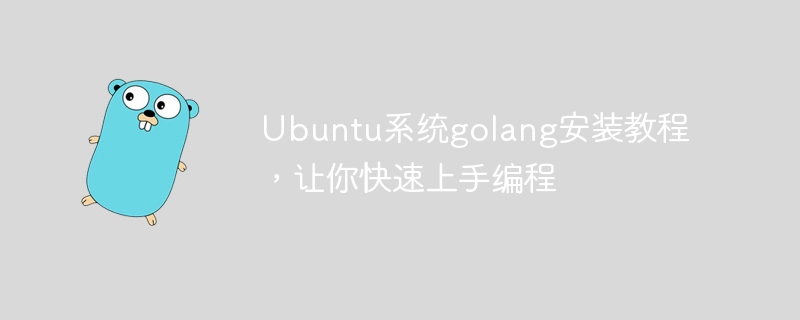

Ubuntu system golang installation tutorial, allowing you to quickly start programming
Overview:
Go language (Golang) is an open source programming language developed by Google . It is simple, efficient, fast and secure, and is widely used in fields such as network services, distributed systems and cloud computing. This article will teach you how to install Golang on Ubuntu system and provide specific code examples to help you get started with programming quickly.
Step 1: Download and install Golang
Open the terminal and execute the following command to download the Golang installation package:
wget https://golang.org/dl/go1.xx.x.linux-amd64.tar.gz
Note: Replace the " 1.xx.x" is the latest version number, for example: 1.17.4.
Decompress the installation package:
sudo tar -C /usr/local -xzf go1.xx.x.linux-amd64.tar.gz
Set environment variables:
Enter the user's home directory, edit the .bashrc file:
nano ~/.bashrc
Add the following content at the end of the file:
export PATH=$PATH:/usr/local/go/bin export GOPATH=$HOME/go export PATH=$PATH:$GOPATH/bin
Save and exit the .bashrc file, and run the following command to make the configuration file take effect:
source ~/.bashrc
Step 2: Verify installation
Enter the following command in the terminal to check the Golang version:
go version
If it is displayed Golang version information, indicating successful installation.
Execute the following command to check whether the Go environment variables are configured correctly:
echo $GOPATH
If the path is displayed as the go directory under your user home directory, the configuration is successful.
Step 3: Write and run your first Go program
Create a new folder and enter the folder:
mkdir hello cd hello
Create a file called hello.go and open it with a text editor:
nano hello.go
Enter the following in hello.go Code:
package main
import "fmt"
func main() {
fmt.Println("Hello, World!")
}Save and exit the file, execute the following command to run your first Go program:
go run hello.go
If the terminal outputs "Hello, World!", It means that your Go program ran successfully.
Extended application: establishing a Web server
Through the following code example, you can establish a simple Web server:
package main
import (
"fmt"
"net/http"
)
func handler(w http.ResponseWriter, r *http.Request) {
fmt.Fprintf(w, "Hello, Web!")
}
func main() {
http.HandleFunc("/", handler)
http.ListenAndServe(":8080", nil)
}Save and exit the file, execute the following command Run the Web server:
go run server.go
Enter http://localhost:8080 in the browser. If "Hello, Web!" is returned, it means that your Web server has been successfully established.
Summary:
This article provides detailed steps for installing Golang on Ubuntu systems, and provides simple code examples to help you get started with programming quickly. Through learning and practice, I believe you can master the basic knowledge of Golang and start doing more advanced development. I wish you success in your Golang programming journey!
The above is the detailed content of Installation guide to quickly get started with golang programming under the Ubuntu operating system. For more information, please follow other related articles on the PHP Chinese website!
 What are the common linux systems?
What are the common linux systems?
 Install and configure vnc on ubunt
Install and configure vnc on ubunt
 Ubuntu startup black screen solution
Ubuntu startup black screen solution
 How to define variables in golang
How to define variables in golang
 What are the data conversion methods in golang?
What are the data conversion methods in golang?
 What are the commonly used libraries in golang?
What are the commonly used libraries in golang?
 What is the difference between golang and python
What is the difference between golang and python
 isp chip
isp chip
 How to set textarea read-only
How to set textarea read-only




